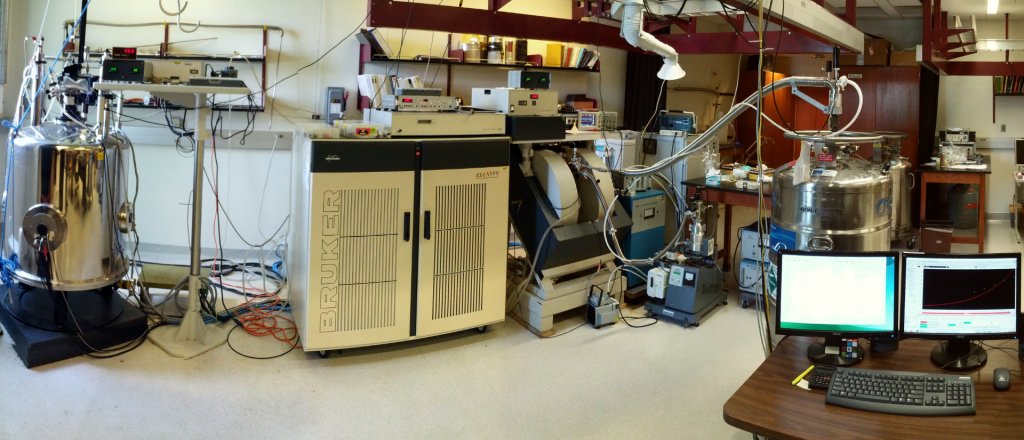The Department of Chemistry and Biochemistry’s instrumentation is updated and expanded continuously to support our faculty members’ and students’ teaching and research. In addition to the major instrumentation listed here, a variety of other equipment — such as chromatographs, spectrometers, electrochemistry apparatus, and organic/biochemical synthesizers — is available to individual research groups.
Nuclear Magnetic Resonance (NMR)
The department’s Nuclear Magnetic Resonance (NMR) facility houses regularly upgraded Bruker spectrometers operating at 600, 500, and 360 MHz. Our NMR instruments are capable of observing all magnetic nuclei between 103Rh and 1H, and current applications involve the more common 1H, 2H, 13C, 15N, 17O, 19F and 31P nuclides as well as studies of 11B, 23Na, 27Al, 29Si, 75As, 77Se, 125Te and 205Tl nuclides. The instruments are configured to employ pulse-sequences for multi-dimensional NMR experiments.
The facility is maintained by a full-time PhD spectroscopist, Dr. Ken Belmore, who is available for consultation and assistance.

Mass Spectrometry
The Mass Spectrometry Facility, hosted in the UA Department of Chemistry and Biochemistry, provides mass spectrometry analysis service and support including EI high resolution, ESI high resolution, GC-MS, GC-MS/MS, LC-MS, LC-MS/MS, and MALDI/TOF. The facility currently has 5 mass spectrometers, as well as a new MALDI/TOF-TOF spectrometer (acquired spring 2018).
X-Ray Diffraction
We maintain a facility for determining crystal structures of compounds of interest to members of the department. Use of our Rigaku XtaLAB Synergy-R DW – Single Crystal X-Ray diffractometer (SC XRD) permits the structural solution of approximately 500 crystal structures per year.
Surface Characterization
Housed in the Bevill Building northeast of Shelby Hall is a Kratos Axis 165 SAM/XPS system used by the materials researchers across campus. The system is a multi-technique surface science tool capable of performing scanning electron microscopy and Auger mapping of surfaces on the nanometer scale. The system, which consists of an ultrahigh vacuum (<10-9 Torr) sample transfer and analysis chambers onto which the analytical equipment is mounted, also has an X-ray photoelectron spectroscopy attachment that allows identification of the surface composition and the oxidation states of many elements.
Alabama Analytical Research Center AARC
Located primarily in the Bevill Building, the Alabama Analytical Research Center AARC houses a variety of instruments used by chemistry department and Materials for Information Technology researchers, including transmission electron and scanning electron microscopes.
Electron Paramagnetic Resonance (EPR)
This 1,300-square-foot laboratory features four state-of-the-art research instruments:
X-Band/Q-band CW-EPR Spectrometer
Varian E-12 EPR spectrometer with 9-GHz (X-band) and 35-GHz (Q-band) microwave bridges, rotating magnetic base, rapid scan accessories, a Varian Century series EPR system with 1a 2-inch magnet. EPR data acquisition is provided by a PC (3 GHz running Windows XP) via the platform-independent data acquisition module (PIDAM) connected to the spectrometer.

X-Band CW-ENDOR Spectrometer
A Bruker-ESP 300-10/7 with an ESP 350-U DICE ENDOR/TRIPLE accessory and an A-500 RF power amplifier allows CW ENDOR measurements in the 0.3–35 MHz frequency range at temperatures from 100 K up to 350 K.
X-Band Pulsed-EPR Spectrometer
Bruker ELEXSYS E-580 pulsed-EPR spectrometer includes the E-560D-pulse ENDOR and E-580-pulse ELDOR accessories. This allows us to operate echo-detected EPR, 2- and 3-pulse 1D ESEEM, 2D ESEEM (HYSCORE), pulsed ENDOR, pulsed ELDOR (DEER), inversion recovery and transient EPR at 9-10 GHz. We plan to add a TRIPLE accessory to the set-up soon. The X-band cavity has optical access and temperature of the cavity is maintained with a liquid-helium cryostat.
W-Band CW/Pulsed EPR/ENDOR Spectrometer
Bruker ELEXSYS E-600 W-band (94 GHz) EPR spectrometer was acquired in 2002, and was upgraded in 2005 with an ELEXSYS E-580 pulse EPR spectrometer. The combined system is known as an E-680 W/X. This instrument was obtained through NSF MRI (W-band CW-EPR system) and the CRIF (pulsed EPR) Instrumentation Programs. At 94 GHz we can perform echo-detected EPR, 2- and 3-pulse 1D ESEEM, inversion recovery, transient EPR, and pulsed ENDOR in the frequency range from 1.5 to 400 MHz. The temperature of the cavity is maintained with a liquid-helium cryostat, and in situ irradiation of the cavity is possible using a fiber optical cable run down through the sample rod. The E-680 W/X system is controlled through a Linux workstation with Xepr, the EPR acquisition and data manipulation software.
Variable temperature attachments are available to perform in situ photolysis from 10 to 400 K using
- Air Products LTD-3-110 Helitran variable temperature system
- Oxford ESR-900 variable temperature system
- Janis Super Varitemp Dewar with optical tail for carrying out UV/visible or X-ray irradiation from 2 to 300 K

UV/visible radiation sources for producing radical and excited intermediates include
- Quantel/BRILLIANT Q-switched Nd:YAG laser (355nm, 532nm, 1064nm)
- Questek 2540 VB Excimer laser
- Spectra Physics 5200 B dye laser
- Molectron pulsed nitrogen laser
- Kratos variable wavelength (200-700 nm) 1-kW Hg/Xe system
- High-pressure Hg arc lamp